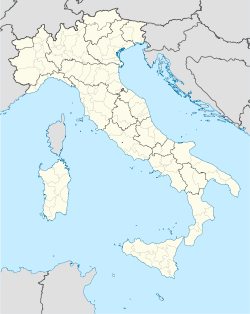- Ottaviano
-
For the wine grape also known as Ottaviano, see Cinsaut.
Ottaviano — Comune — Comune di Ottaviano Location of Ottaviano in Italy Coordinates: 40°51′N 14°29′E / 40.85°N 14.483°ECoordinates: 40°51′N 14°29′E / 40.85°N 14.483°E Country Italy Region Campania Province Province of Naples (NA) Frazioni Furchi, San Gennarello, Zabatta Area – Total 19.8 km2 (7.6 sq mi) Highest elevation 1,281 m (4,203 ft) Lowest elevation 50 m (164 ft) Population (December 2004) – Total 23,572 – Density 1,190.5/km2 (3,083.4/sq mi) Demonym Ottavianesi Time zone CET (UTC+1) – Summer (DST) CEST (UTC+2) Postal code 80044 Dialing code 081 Patron saint San Michele Saint day 8 May Ottaviano is a comune (municipality) in the Province of Naples in the Italian region Campania, located about 20 km east of Naples and is located in the Vesuvian Area. Ottaviano was in Roman times a hamlet of houses within a vast estate (praedium Octaviorum) belonging to the gens Octavia, Augustus's family. As of 31 December 2004, it had a population of 23,572 and an area of 19.8 km².[1]
The territory of the country includes most of the crater of Vesuvius. The city of Ottaviano contains the frazioni (subdivisions, mainly villages and hamlets) Furchi, San Gennarello, and Zabatta. Ottaviano borders the following municipalities: Boscotrecase, Ercolano, Nola, San Gennaro Vesuviano, San Giuseppe Vesuviano, Somma Vesuviana, Terzigno, Torre del Greco, Trecase. In Ottaviano, in the Medici Castle, is located the headquarters of the National Park of Vesuvius.
Ottaviano suffered significant destruction during the 1944 eruption of neighboring Mount Vesuvius. Now the city is home to the center office of Vesuvius National Park. In late 1980, Ottaviano was firmly under the control of the Camorra.
History
Ottaviano was in Roman times a hamlet of houses within a vast estate (praedium Octaviorum) belonging to the gens Octavia, Augustus's family. The territory was the scene of a battle between Lucius Cornelius Silla and Lucius Cluenzio, occurred in 90 BC, during the Social War. On the territory of Ottaviano, during the first Servile War, in 73 BC, Spartacus defeated the two praetor, Gaius and Publius Clodius Vatin sent from Senate. The village (Octavianum) grew in importance becoming Municipality. According to some historians, there would be dead the Emperor Augustus, then moved to Nola. The remains of the Roman era were buried by successive eruptions of Vesuvius, but the ruins and tombs have been unearthed in excavations in various parts of the country.
In 1085, Pope Gregory VII visited the city and celebrated mass in a church (church of Vaglio) located at the baronial castle ( today palace Mediceo). Several Lords and Barons had held the city. In the thirteenth century was in possession of Thomas Aquinas, grandfather of Thomas Aquinas. During Angevin rule in 1304 the village was put to fire and sword by Carlo di Lagonessa by order of Charles II d'Anjou, cause the killing of a regional officer ("superintendent of the woods") and his escort from the brothers John and Roberto de Marrone.
Between 1532 and 1551 was the fief of Maramaldo Fabrizio, who had obtained the services rendered to Charles V. The feud was then transferred to Gonzaga of Molfetta and after, in 1567 to Bernadetto de 'Medici, cousin of the Grand Duke Cosimo de' Medici. The fief remained in possession of this family until 1860 and also included the current municipalities of Terzigno and San Giuseppe Vesuviano. The de 'Medici family was part Luigi de' Medici, the representative of the Kingdom of Naples at the Congress of Vienna.
The city has long suffered from vesuvian eruptions, especially the city was almost completely buried by volcanic ash of Vesuvius's eruption of 1631, 1779 and 1906. According to William Hamilton, during the first and second eruption Ottaviano "was buried like Pompeii", and so even in the third, as testified Matilde Serao calling the city "the new Pompeii". In the third eruption also the imponent roof of the Mother Church of San Michele Arcangelo collapsed by the weight of the ash, fortunately without killing anyone.
Ottaviano in the eighties became painfully famous for being the general headquarters of the Nuova Camorra Organizzata, a powerful Camorristic organization headed by Raffaele Cutolo. Currently, despite the strong presence of organized crime, the citizens of Ottaviano, hardened to fight violent destroyer Vesuvius of over two thousand years, are trying to combat this bad and undeserved reputation doing Ottaviano a city of peace and culture.
Demographic evolution

References
Categories:- Cities and towns in Campania
- Communes of the Province of Naples
Wikimedia Foundation. 2010.

